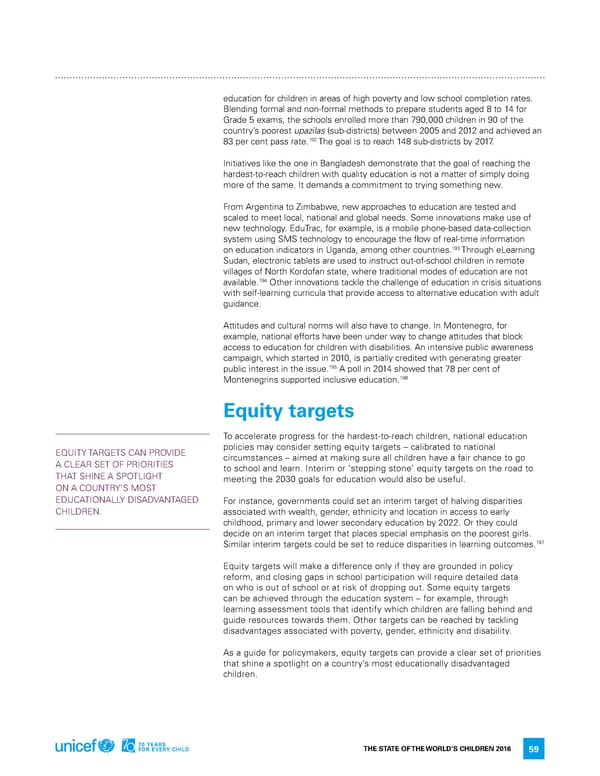education for children in areas of high poverty and low school completion rates. Blending formal and non-formal methods to prepare students aged 8 to 14 for Grade 5 exams, the schools enrolled more than 790,000 children in 90 of the country’s poorest upazilas (sub-districts) between 2005 and 2012 and achieved an 192 83 per cent pass rate. The goal is to reach 148 sub-districts by 2017. initiatives like the one in Bangladesh demonstrate that the goal of reaching the hardest-to-reach children with quality education is not a matter of simply doing more of the same. it demands a commitment to trying something new. from argentina to Zimbabwe, new approaches to education are tested and scaled to meet local, national and global needs. Some innovations make use of new technology. eduTrac, for example, is a mobile phone-based data-collection system using SMS technology to encourage the flow of real-time information 193 on education indicators in Uganda, among other countries. Through elearning Sudan, electronic tablets are used to instruct out-of-school children in remote villages of north Kordofan state, where traditional modes of education are not 194 available. other innovations tackle the challenge of education in crisis situations with self-learning curricula that provide access to alternative education with adult guidance. attitudes and cultural norms will also have to change. in Montenegro, for example, national efforts have been under way to change attitudes that block access to education for children with disabilities. an intensive public awareness campaign, which started in 2010, is partially credited with generating greater 195 public interest in the issue. a poll in 2014 showed that 78 per cent of 196 Montenegrins supported inclusive education. Equity targets To accelerate progress for the hardest-to-reach children, national education eQUiTY TarGeTS Can ProVide policies may consider setting equity targets – calibrated to national a Clear SeT of PrioriTieS circumstances – aimed at making sure all children have a fair chance to go ThaT Shine a SPoTliGhT to school and learn. interim or ‘stepping stone’ equity targets on the road to meeting the 2030 goals for education would also be useful. on a CoUnTrY’S MoST edUCaTionallY diSadVanTaGed for instance, governments could set an interim target of halving disparities Children. associated with wealth, gender, ethnicity and location in access to early childhood, primary and lower secondary education by 2022. or they could decide on an interim target that places special emphasis on the poorest girls. 197 Similar interim targets could be set to reduce disparities in learning outcomes. equity targets will make a difference only if they are grounded in policy reform, and closing gaps in school participation will require detailed data on who is out of school or at risk of dropping out. Some equity targets can be achieved through the education system – for example, through learning assessment tools that identify which children are falling behind and guide resources towards them. other targets can be reached by tackling disadvantages associated with poverty, gender, ethnicity and disability. as a guide for policymakers, equity targets can provide a clear set of priorities that shine a spotlight on a country’s most educationally disadvantaged children. The STaTe of The World’S Children 2016 59
 70 Years for Every Child Page 74 Page 76
70 Years for Every Child Page 74 Page 76